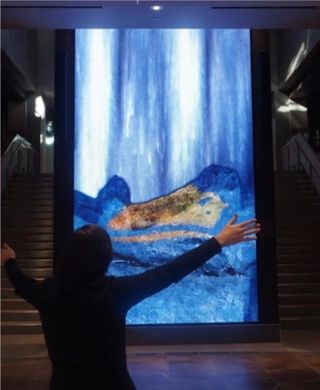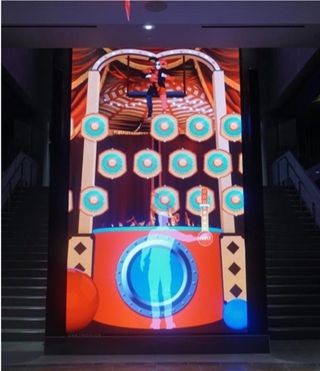As part of a multi-year expansion and beautification project, Seneca Buffalo Creek Casino in Buffalo, NY, recently unveiled a new augmented reality (AR) display developed by award-winning experiential design firm Float4. According to Float4 producer Veronique Laperle, the project combines a collection of interactive moments powered by Float4’s RealMotion media server and content creation platform with a splendid Daktronics direct view LED display to provide visitors with an interactive memento as they enter the casino.
“The first thing guests encounter when they walk through the doors of Seneca Buffalo Creek Casino is a stunning LED canvas that stretches from floor to ceiling, you can notice the effect it has on them,” Laperle said. “It’s a vibrant element that captivates attention. Using Float4’s RealMotion server and a collection of optical sensors, we use the visitors silhouette [to] enhance their connection with the space.” The result is a 15 foot-tall LED display that features nine interactive content capsules, including augmented reality where a live camera feed is composited with pre-rendered assets to surround guests with unique characters, gesture driven visuals, where on-screen graphics and videos change and move based on a guest’s movements, as well as an interactive dunk tank.

The AR capsule uses a video camera concealed beside the display to project a live image of visitors as they enter the property. Content is then composited over this feed to indicate a call to action and invite the audience to participate. The experience is triggered when a visitor stands in the designated location for a pre-defined interval. In one of the capsules, this makes a lifelike buffalo appear to graze at the visitor’s feet. An image is then captured and the user is asked to opt-in for sharing this moment on social media.
To enable silhouette-based interactions, the interactive developer relied on an infrared sensor and the computer vision capabilities of the RealMotion platform. Because of spatial constraints and requirements, it was decided against the use of a more typical 3D sensor which limited the control granularity of interactions. “The goal is to keep things simple and essentially eliminate the learning curve to make the whole experience more intuitive,” Laperle explained.

“Different interactive capsules required different designs and levels of collaboration. For instance, we worked closely with Indirap (a video production company) to integrate their live green screen footage of cheerleaders and a Joker character. The end result is a multi-purpose technology experience that draws in guests and provides a vibrant medium for branding,” said Laperle.
For example, on one of the capsules, the participant has to hit moving targets with a ball so the Joker will fall in a dunk tank. This typically implies the control of vertical and lateral movement (i.e.: X and Y coordinates) as well as a trigger type interaction to fire the projectile at the desired moment. The Float4 design team compared it to “replicating the functionality of a steering wheel and a brake pedal, but you only have a lever at your disposal.”
In order to achieve this, the team came up with the idea of having the targets translate horizontally on separate rows. “By being able to control the intensity of the impulse, the player can decide which row they want to hit, therefore controlling vertical movement. By giving the player the ability to choose when they want to release the projectile, they essentially control the horizontal movement. It’s actually surprising how easy it is for people to pick it up and just have fun,” said Laperle.
The interactive visuals also react to motion to generate and affect a collection of five distinctive capsules with unique aesthetics, including: branded gold particles that shower down and move around the guest’s silhouette, waterfalls that guests can part with their movement to reveal the casino’s logo emblazoned on a rock, dollar bills that flutter around the screen and attract to a guest’s silhouette and playing card mosaics. Last but not least, a generative content capsule creates a continually altering prismatic cascade, which users can gently affect with their gestures.
The RealMotion server manages all the content and includes an easy-to-use scheduler which sets a daily playlist of interactive capsules, interspersed with videos or promotional content added by the casino staff. The main LED display, supplied by Daktronics, features a 4mm pixel pitch and a resolution of 612 x 1020. A second LED display is located at the top of the stairway, and mirrors the content reinforcing the casino’s desired messaging and experience, building momentum before guests reach the casino floor.
In terms of real-time capabilities, RealMotion is designed for maximum speed and pixel throughput for high resolution video playback, interactive and generative content layers while capturing two 4K inputs. RealMotion also sets a new benchmark for reliable 24/7 performance with real-time monitoring — thanks to a design that empowers complex projects while allowing operators to be informed of hardware health status.
“We love the idea of creating a first impression through an interactive experience in the lobby,” Laperle said. “With this project, Seneca Buffalo Creek Casino took what is often the most overlooked part of a casino and turned it into a memorable, shareable experience that requires no extra floor space.”
“Seneca Buffalo Creek’s expansion is one of many advancements across Seneca Gaming Corporation’s properties,” said Melissa Free, senior VP of marketing, Seneca Gaming Corporation. “Continuous engagement and elevating our guest experience is a key goal which is why collaborations such as this with Float4 are so exciting.”









